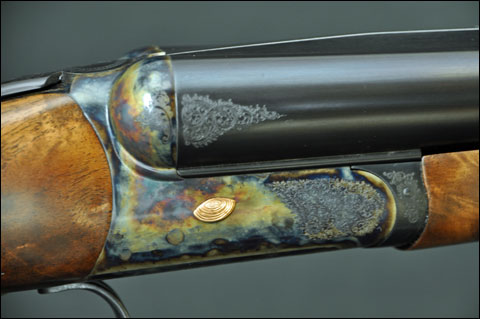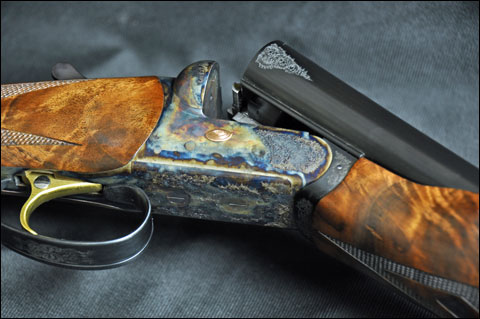Exclusive: First Field Test of the Connecticut Shotgun RBL12 Sporting Clays Model

Question: Who needs it?
Answer: You do (if you qualify).
The question, in fact, arose from our initial reaction to finding the RBL12 Sporting Clays model on the web site of Connecticut Shotgun Manufacturing Company (www.connecticutshotgun.com).
The ultimate answer, however, revealed itself after we spent a few weeks shooting this unusual and remarkable side by side.
The question is a knee-jerk response any enthusiast would have to laying eyes on a 9¾-pound, round-body, 12-gauge side by side with an adjustable comb, single trigger and weight-balancing system inside the straight stock.

“It’s a modern gun built with sporting clays in mind,” said Lou Frutuoso, sales and marketing manager at Connecticut Shotgun.
And right there stands the contradiction: a modern side by side for sporting clays. As Mr. Frutuoso further explained, the RBL12 Sporting Clays is designed for a handful of vintage-minded shooters who expend a lot of time and money modifying their beloved old bird guns for competitions unique to side by sides.
But shoot the RBL12 Sporting Clays shotgun and you form a different impression: this is one fine side by side that could easily level the sporting clays playing field among the over/under and semi-auto bigots. Okay, you won’t find an RBL12 Sporting Clays grab the gold at the NSCA National Championships. But for everyday Joes with a round of beers on the line, Connecticut Shotgun’s RBL12 Sporting Clays side by side could easily be the sleeper that comes through for that mug full of suds.
The RBL12 Sporting Clays shotgun pushed all our buttons. We like round-body side by sides with single triggers. We prefer adjustable combs. The reliability of a new side by side always trumps the charm of an old one (with the exception of a Purdey, Holland & Holland and a handful of others). And we’re very keen on screw-in chokes.
So this mash-up of side-by-side preferences, measured against the preconceptions of the sporting clays community at large, actually made the RBL12 Sporting Clays shotgun somewhat complicated to locate on the Connecticut Shotgun web site. In fact, we sort of stumbled on it.
For anyone interested in following our bread crumbs, here’s the trail…
Go to www.connecticutshotgun.com and find the section that reads:
The RBL Reserve
Redefining American Craftsmanship
Click on that panel and the next page explains….
Welcome to the Last of the RBL’s,
The RBL Reserve
We are proud to announce the RBL RESERVE shotguns; these guns are hand built one at a time by our senior-most gunsmiths and are released to the gunroom for sale in very, very limited quantities. In terms of quality and performance, the RBL RESERVE shotguns are in a class all of their own. These guns are superb, and every mechanical aspect of these guns reflects our dedication to craftsmanship. These guns are truly the absolute best of the best.
Once you’re on that page scroll down past the RBL-12 Reserve, the RBL-16 Reserve, the RBL-20 Reserve, the RBL-28, the Reserve RBL-Professional 20 Gauge Double Rifled Sabot Slug Gun (the photo of an RBL with a scope makes it very tempting to take a detour here but keep on going) until you reach the RBL12 Sporting Clays (can’t miss it, you’ll see the photo of the split stock on the exhibition-grade American walnut).
Today, the RBL Reserve family of side by sides marks the last iteration of these incredibly popular shotguns that have been successfully sold for about the past five years. In the annals of American gunmaking, the RBL is distinguished as a present-day, affordable side by side marketed directly by Connecticut Shotgun through a ubiquitous campaign that helped firmly plant the company into the consciousness of American sportsmen.
The Reserve designation clearly refers to a premium-grade, handmade shotgun in the waning days of the RBL. As the RBL marks the end of the line with the Reserve, production capacity is being shifted to the new A-10 sidelock over/under, which carries Connecticut Shotgun’s torch of affordability, ingenuity and workmanship for American shotguns. (see our review of the A-10 American prototype here.)
The RBL12 Sporting Clays, though, thrusts the marque into a highly specialized – even experimental – derivative whose unique calling and small production make it a candidate as one the most collectible RBLs to emerge from the New Britain, Connecticut factory.
Indeed, Mr. Frutuoso said there would be a “very limited production” of the RBL12 Sporting Clays shotgun. The web site lists only two of the shotguns priced at $6,995 available for immediate delivery, a smidgen of the inventory compared with other new RBLs currently listed. Although there is no hard stop in sight for production of the RBL12 Sporting, orders for the shotgun are taken on a first-come basis with a turn-around time of about 30 days, according to Mr. Frutuoso.

The split stock and pistol grip are certainly clues to the shotgun’s identity, but look closely at the case-colored receiver and you’ll see a diminutive, gold clay target angled in flight. Harder to detect is the shotgun’s quick release interchangeable recoil pad system allowing either 14¼ inch or 14¾ inch length of pull. A ¾ turn of both Dzus fasteners with a Phillips screwdriver instantly separates the recoil pad.
(For folks familiar with Tony Galazan, owner of Connecticut Shotgun, the use of Dzus fasteners on the RBL12 Sporting should come as no surprise. Dzus fasteners are widely employed on race cars and Mr. Galazan is known for his love of Ferraris and other high-speed exotics.)
Remove the recoil pad and you’ll see the internal weight system that adds about ¾ pound to the RBL12 Sporting. It’s similar to the Blaser F3 – a threaded rod with weights that can be adjusted up and down to shift balance fore and aft. This type of system is effective in both reducing the see-saw effect of mounting a nose-heavy shotgun as well as absorbing recoil. Likewise, the 9¾-pound shotgun mounted evenly, smoothly and predictably thanks to its composed set-up out of the box.
The broad vented rib evoked the deck of an aircraft carrier as it tapered from ¾ inch to ½ inch. Unusual for a clays gun, it lacked a center bead. Not quite sure about the reasoning for a front-bead only implementation, but Mr. Frutuoso explained that the RBL12 Sporting could be ordered with the second bead.
Another puzzling aspect of the rib was a smooth, blued lacquer finish. We didn’t encounter glare problems, but it was unusual compared with the textured satin surface of most shotguns.

We thought the rib came across as an affectation and would have appreciated a traditional rendition. That said, however, the rib greatly enhanced the overall appearance of the RBL12 Sporting and didn’t detract from the positive experience of shooting it, although we still would have ordered the shotgun with a center bead.
Starting with the rib, pundits will debate the merits of a side by side for sporting clays – arguing that the wider sight plane is better suited to rising and quarter targets rather than some of the low, fast crossers you’ll see in sporting clays and skeet.
We put this theory to the test by taking the RBL12 to the skeet field. Of the five standard flush-mounted Trulock chokes packaged with the RBL12 Sporting, we installed skeet in the first barrel and improved cylinder in the second. We discovered no apparent difference in our scores between the RBL12 Sporting with its 30-inch barrels and the semi-auto we typically use on skeet.

Prior to skeet we had spent about 30 minutes patterning the RBL12 Sporting. The adjustable comb was tweaked in increments until we achieved a roughly 60/40 spread centered at 30 yards shooting 1-ounce Winchester loads with a full choke.
Between the patterning board and skeet we walked away quite happy with the RBL12 Sporting and felt that at some level we proved that a side by side could be successful at clays.
But the sporting clays course proved a bit more challenging. The first six stations or so turned out to be more warm-up than we originally hoped; by about station seven we were dialed into the RBL12 Sporting. The overall impression was that if Krieghoff made a target side by side it would be the RBL12 Sporting. It was as though Connecticut Shotgun private-labeled a Krieghoff K-80 side by side for the fabled German gunmaker. The RBL12 possessed a similar heft and swing only with a much wider sight plane.
The trigger pull on the RBL12 Sporting averaged 7 pounds – certainly heavier than the 3½ – 4 pounds Krieghoff cites for its K-80 Sporting. Still, we would challenge any shooter to say the inertia trigger on the RBL12 Sporting felt heavy. From our experience, the trigger fell into a category of controlled versus hard, requiring a measured pull rather than a violent slap to overcome resistance.

Perhaps most surprising was that the 7-pound trigger wasn’t a factor at all in skeet. In retrospect, we would chalk it up to the consistently faster shooting times in skeet that demanded more of an instinctive reaction than sporting clays. Beyond that, we have no explanation for it.
In reviewing our on-course diary of shooting the RBL12 Sporting, we saw notations such as….
“Handled more like a Mercedes than a Lotus.”
“Shouldered easily.”
“Surprisingly agile.”
“No parts rattled, high quality.”
“Gun opened easy, great auto eject”
“Wood alone worth 4K”
Connecticut Shotgun’s RBL12 Sporting conveys a high level of quality. The case hardening was meticulous with a subtle scroll pattern framing the gold clay target. The fit and finish between the stock and receiver was even and tight. A ½-inch wide trigger guard and tang were one piece that flowed into the end cap as an elegant stretch of blued steel. The barrel selector was in the trigger rather than the top tang, further contributing to the shotgun’s stylish profile.
The wood possessed an oil finish certainly worthy of its exhibition designation. Checkering was 22 lines per inch at a 3.5 ratio to one for both the pistol grip and beavertail forend.

The RBL12 Sporting is equipped with an auto safety and non-adjustable, gold-plated trigger. The action, meanwhile, is the same as other RBLs – an Anson & Deeley boxlock buttressed for additional strength and modified to fit the rounded frame.
After the parts are machined, Connecticut Shotgun applies Hard Gold, a trademarked process derivative of titanium nitrate. While the gold prevents rust, titanium adds the hardness of a cutting tool – especially helpful where the hammer and sear engage.
Connecticut Shotgun uses other trademarked technologies when it comes to the barrels. After the barrel blank is gun drilled and then turned, the barrels are put into a very deep freeze in a process that the company calls Cryo Pattern. It releases the stress caused by the extreme forging operations of the barrel tubes. Cryo Pattern stops warping and twisting of the tubes, especially after repeated shooting reheats the barrels.
Inside the bores, the company’s trademarked Tuff Bore plating allows you to shoot any type of shot without damaging the barrel.
Add it all up and the RBL12 Sporting is a laudable and welcome contender to the world of recreational clays.
So what it would take for you to qualify as a proud owner of an RBL12 Sporting? In a word, “contrarian.” In the universe of vintage side-by-side sporting-clays competitions, you would have to stand tall among a legion of purists. For sporting-clays weekend warriors, you should possess the mettle to weather the inevitable macho send ups from the over/under and semi-auto guys in your squad.
The upshot of course is ownership of a unique American side by side that qualifies you for membership into an elite group of shotgun aficionados.
Irwin Greenstein is Publisher of Shotgun Life. You can reach him at letters@shotgunlife.com.
Helpful resources:
Connecticut Shotgun’s web site

Irwin Greenstein is Publisher of Shotgun Life. Please send your comments to letters@shotgunlife.com.


Comments